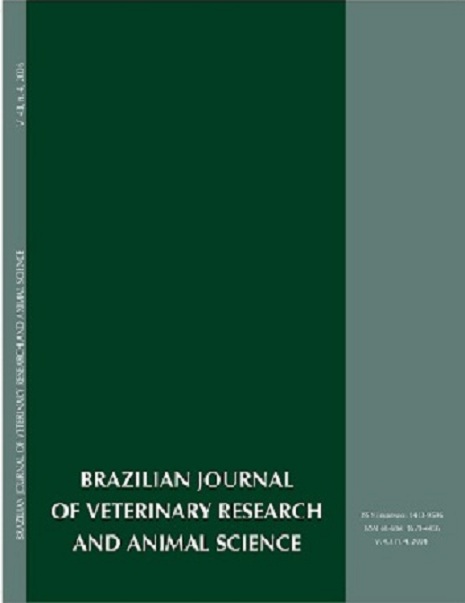Induced molt in Guinea fowls (Numida meleagris) through the use of zinc oxide
DOI:
https://doi.org/10.11606/issn.1678-4456.bjvras.2006.26459Keywords:
Forced Molt, Guinea Fowls, Ovary, Oviduct, Zinc OxideAbstract
Due to scarcity of studies on forced molt in alternative production birds, this experiment had the objective of performing an induced molt in Guinea Fowls observing the best body weight losses (BWL) that could promote good post-molt productions. With this purpose, 110 Guinea fowls were housed in individual commercial cages and were submitted to induced molt through the addition of zinc oxide in feed with the concentration of 20000 ppm during 21 days and received drinking water ad libitum. In the analysis of BWL related to post-molt productivity, 60 birds were organized in the groups, according to the percentage of BWL: 24% (n=18), 26% (n=18), 28% (n=12) and more than 30% (n=12). The other 50 birds were sacrificed for analyses of the reproductive organs, in which the oviduct size and weight of oviduct and ovary were measured with 0% of BWL and since then the regression of these organs were calculated to 24%, 26%, 28% and more than 30% of BWL. The medium of post-molt return to production was 60% and the group of 24% of BWL presented the best productive return (100%), however this group presented an insufficient production rate as the birds with 30% of BWL. In this way, the induced molt in Guinea fowls was viable with BWL around 26 and 28% and unviable with less than 24% or more than 30%. In relation to regression of the reproductive organs the best productive results were 65,15%, 90,49% and 94,27% to oviduct size and weight and ovary weight, respectively.Downloads
Download data is not yet available.
Downloads
Published
2006-08-01
Issue
Section
UNDEFINIED
License
The journal content is authorized under the Creative Commons BY-NC-SA license (summary of the license: https://
How to Cite
1.
Teixeira RS de C, Romão JM, Câmara SR, Oliveira WF de, Sobral MHNR, Siqueira AA de, et al. Induced molt in Guinea fowls (Numida meleagris) through the use of zinc oxide. Braz. J. Vet. Res. Anim. Sci. [Internet]. 2006 Aug. 1 [cited 2024 Apr. 19];43(4):448-55. Available from: https://www.revistas.usp.br/bjvras/article/view/26459





